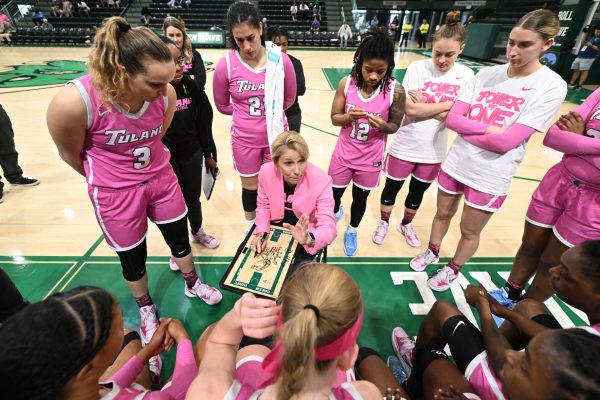Letter to the Editor: Don’t stigmatize a woman’s right to choose self-managed abortion
October 16, 2019
Lily Milwit is a second-year student at Georgetown Law School and a Tulane ‘18 graduate. She previously served as the Editor-in-Chief of The Tulane Hullabaloo.
Dear Editor,
The Tulane Hullabaloo published an opinion article on Oct. 3 titled “Louisiana laws will lead to life-threatening self-managed abortions.” The article is thoughtful, and I whole-heartedly support publishing content on this issue, especially given the Supreme Court’s announcement that it will hear oral arguments for June Medical v. Gee, a case whose outcome could leave Louisiana with only one operating abortion clinic.
Though I appreciate the author’s insights and respect her experience as an NCI and Planned Parenthood intern, I want to call attention to some of the misconceptions about self-managed abortion that this article endorses and perpetuates.
To be clear, abortion bans and legislation like Louisiana’s “heartbeat bill” are, in my view and the view of the U.S. Supreme Court for decades, unconstitutional. Furthermore, such legislation threatens the safety and autonomy of millions of people.
Even with Roe v. Wade still standing, Kavanaugh and Gorsuch can decimate abortion access. SCOTUS’s decision in June Medical Services v. Gee could allow legal abortion to be regulated out of existence. https://t.co/6c1D6TA8Tx #MyRightMyDecision
— NARAL (@NARAL) October 13, 2019
Certainly, such policies will mean that some pregnant folks will turn to self-managed abortion. But I hope to problematize the narrative espoused in the original article that self-managed abortion is always unsafe or that it is always the backup plan for pregnant people left with no other choice. Such a narrative only reinscribes the criminalization of self-managed abortion and undermines the philosophy and ethics of reproductive justice — the idea that there is a human right to bodily autonomy.
As ReproAction provides on its website, there are many reasons why one may manage their abortion outside of a clinic setting. If we adopt the ideology of reproductive justice — that all people are capable of determining what is best for their bodies — then we acknowledge that all people have the right to access abortion and can choose to pursue an abortion in whichever way they deem most practical for them and most compatible with their lifestyle and circumstances.
If someone wants a medical abortion in a clinic setting and does not have access to that because of laws, policies, bans and other forms of structural inequity, that is reproductive injustice. But if someone chooses to pursue self-managed abortion and we assume that their choice is, as the author says, a “last-ditch effort” or “carried out in back alleys,” that is also reproductive injustice.
While the author is correct that managing one’s own abortion can lead to physical and emotional trauma, self-managed abortion can also be a safe, effective and empowering alternative to medical interventions. Misoprostol combined with mifepristone is 96 percent effective when used correctly, as the author points out. Like any other medication, self-managed abortion pills can lead to side effects and complications, but using these pills as directed is deemed “extremely safe” by Plan C, and the World Health organization endorses their use.
The reality is that self-managed abortion can be a safe alternative for those who might be hesitant to engage with the traditional medical community. And communities of color have reason to be skeptical of such traditional medical institutions, including clinic settings that may offer surgical abortion. During the infamous “Tuskegee experiment,” researchers failed to get informed consent from 600 black men and were misled about the study’s purpose. Told they would be treated for syphilis, the men were not given treatment even when penicillin, a highly effective treatment for syphilis, became available. And many know the story of Henrietta Lacks, a black woman whose cell matter was taken, reproduced and sold without her consent and without compensation to her or her family for decades.
A portrait of Henrietta Lacks, whose cells were taken without her consent and widely used in groundbreaking research, will be installed at the Smithsonian’s National Portrait Gallery. https://t.co/tDs7nGvlO2
— NBCWashington (@nbcwashington) May 11, 2018
And these are just two of the most prominent examples of the traditional medical community exploiting and misleading communities of color. For many folks of color today, refraining from participation in medical institutions can be a means of preserving safety and dignity. The ability to self-manage an abortion, in this sense, can be empowering and may well be the first choice for people even when they do have legal access to a traditional clinic setting.
Furthermore, women of color, transgender folks and gender noncomforming or gender nonbinary people are routinely denied access to health care, including reproductive health care. When they are granted access, it often comes at the cost of involuntarily outing themselves, facing humiliation or embarrassment at the hands of outdated and exclusionary policies and practices, and having to make compromises when it comes to their own preferences and beliefs. For them, self-managed abortion has been, and continues to be, a useful resource that provides safety and privacy without the challenges of navigating a health care system not built to include them and their families.
Importantly, we must also remember that surgical abortions in clinic settings have always been accessible to only a small handful of pregnant people, even when access became a legal right in 1973. Because of our country’s centuries-long commitment to enslavement, black women have historically been stripped of reproductive autonomy in a way that white women have not been. This tension is what led a group of black women to create the Reproductive Justice movement in 1994, to acknowledge that the reproductive rights movement led by middle-class and wealthy white women could not adequately advocate for and protect the rights of women of color and trans people.
For those who have historically been denied access to “traditional” abortions, framing self-managed abortion as inherently inferior or automatically a “last-ditch effort” only further devalues the difficult choices that these communities have had to make in the face of a system and a narrative that has excluded them. For those who fought to destigmatize and make accessible self-managed abortion for themselves and their communities, this is a grave injustice.
Ultimately, phrases like “back alley abortion” reflect our collective fear about returning to a pre-Roe v. Wade era, when a person had no legal right to end an unwanted pregnancy, regardless of how they chose to do so. This fear is well-founded and appropriate given the current makeup of the Court and the looming June Medical oral argument date on the Court’s docket. But continuing to frame self-managed abortion as a “last-ditch effort” overlooks the realities of the historical and contemporary landscape in which we live.
“Self-managed abortion looks very different than it did years ago – and can be very safe, too.
“https://t.co/3sJIrJxUXJ— Center for Reproductive Rights (@ReproRights) October 21, 2018
Advocating for reproductive justice should mean advocating for a future in which all people can choose if, when and how to raise a family — using whichever methods they deem to be appropriate for their own bodies and their lives. Bills like Louisiana’s “heartbeat bill” and the House amendment that the author mentions should be overturned because they undermine a person’s right to choose and because, as the author points out, they will indeed force pregnant people who wish to terminate their pregnancies to resort to unsafe measures.
But a truly comprehensive and intersectional advocacy approach should also not vilify or stigmatize the choice to self-manage an abortion. It should seek to provide information and access to self-managed abortion for those who are interested in foregoing clinical abortions, while also ensuring that such choices are made free from violence and coercion. No one should fear ostracization or criminalization for their reproductive choices, and no one should be forced to make a choice with which they are uncomfortable because of who they are, how they present, who they love, where they live or their community’s history with medical institutions.
Those of us, like myself and the original author, who care about these choices and how they are made must do the work of challenging popular narratives about abortion, listening and advocating for one another’s capacity to make our own choices regardless of if, where, how and why we choose to exercise our reproductive rights.






















Leave a Comment